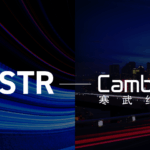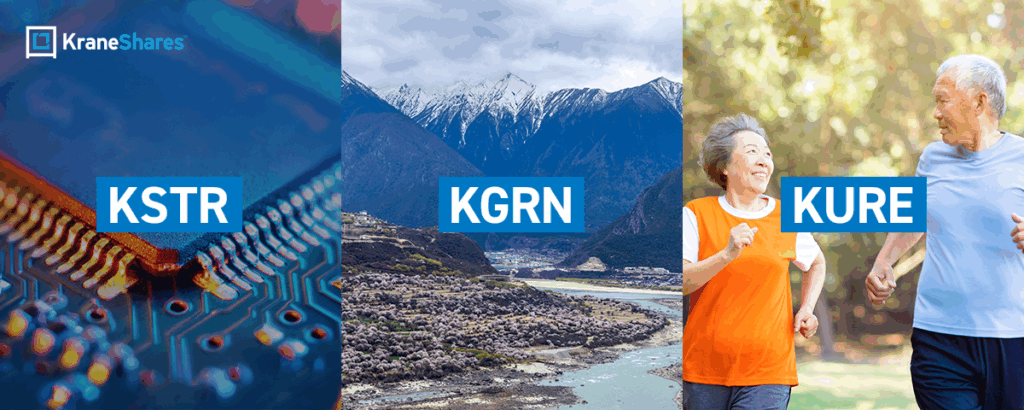
China Thematic Update: New IPOs (KSTR), Healthcare Momentum From Regulatory Reprieve & Innovation (KURE), New Hydroelectric Dam (KGRN)
China's re-rating this year, driven by stimulus measures and policy reforms, could lead to increased global flows to the country's equity market, the second-largest in the world. Hong Kong's Hang Seng Index is up +28.91% year-to-date (YTD) as of August 22, 2025, while the Shanghai Composite is up +18.68%, compared to the S&P 500 Index, which is only up 10.87%.1 Meanwhile, beyond more well-known themes like China Internet, we are seeing significant potential catalysts this year in China’s STAR Market, health care, and clean technology, and, in some cases, these themes are outperforming the broad benchmarks.
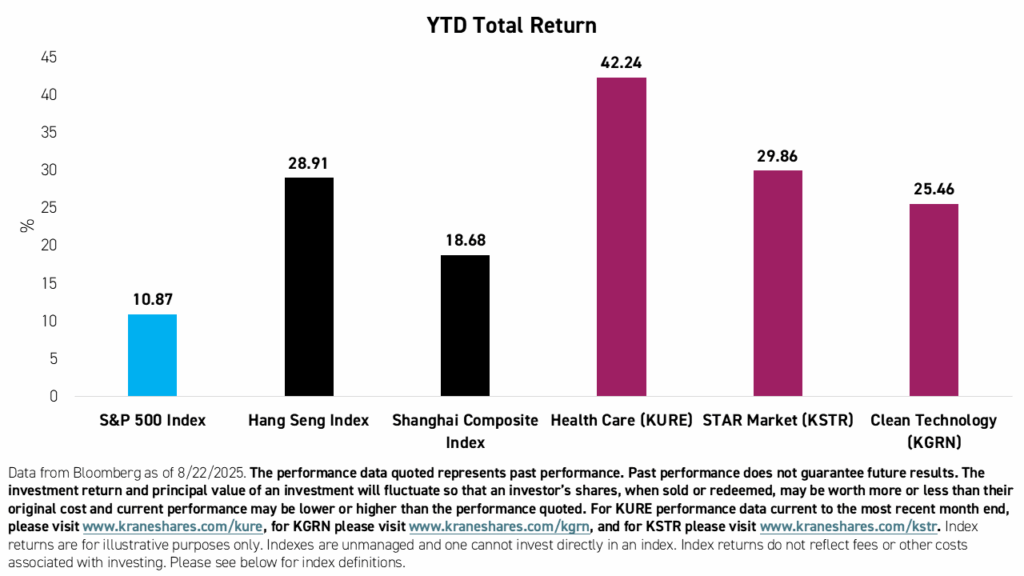
For investors thinking of increasing their China allocations, we believe these themes are worth consideration as complements to an exposure to broad China. Not only are these themes seeing potential catalysts right now, but they also could be important for China's economy going forward due to demographic shifts and technological changes.
KSTR: The Startup IPO Spigot Gets Turned On Again
On June 18th, the Shanghai Stock Exchange (SSE) announced that the STAR Market would once again welcome the listings of pre-profit companies after a multi-year suspension of the policy. Pre-profit companies that meet the industry classification requirements and high R&D thresholds set forth by the SSE will now be approved for listing as part of a new “Sci-Tech Growth Tier”. According to the SSE, this tier is designed to support high-quality, unprofitable technology-based companies by easing listing requirements and improving investor protections.2
The first IPO under the new regime will be Healthgen Biotechnology Corp. The SSE recently announced that the company’s listing had been approved after years of back-and-forth between the company, the exchange, and regulators. Healthgen Biotechnology was founded in 2006 and focuses on recombinant human albumin serum, essentially artificial blood plasma proteins. The serum is a brand-new innovation with numerous potential medical and cosmetic applications, and Healthgen does not currently have any competitors in the space.
A total of 54 pre-profit companies have listed on the STAR Market. Out of those, nearly half have achieved profitability in the years since listing.2 Companies in the “Sci-Tech Growth Tier” have an extra incentive to turn a profit: they are demarcated with a “U” at the end of the official name used by the exchange. Companies can “graduate” from the tier after achieving a cumulative profit of over RMB 50 million in two years or achieving any profit level from a revenue of RMB 100 million or above.
Historically, the Hong Kong, Shenzhen, and Shanghai stock exchanges were closed off to pre-profit enterprises due to strict profit and revenue requirements. This is one reason so many of China’s startups first went to list in New York. The STAR Market was built to entice startups in specific industries, primarily health care and information technology, to list shares locally.
According to the SSE, Healthgen’s listing will “further strengthen the STAR Market's role as a ‘testing ground' for reform, better promoting the deep integration between technological and industrial innovation, and providing stronger support for achieving high-level technological self-reliance and self-strengthening, as well as fostering the development of new quality productive forces.”
The current pipeline for pre-profit IPOs in the STAR Market is led by two key industries: biotechnology and computer hardware. In addition to Healthgen’s upcoming listing, Guangzhou Be Better Medicine Technology, and Hrain Biotechnology are also preparing to list. In the hardware space, among the top listing candidates are producers of graphics processing units (GPUs), which are heavily used in AI fields, Moore Threads and MetaX.
The KraneShares SSE STAR Market 50 Index ETF (Ticker: KSTR) is the only US-listed ETF providing access to this exciting IPO market.1 The fund holds the top 50 largest companies based on free-float market capitalization listed on the STAR Market.
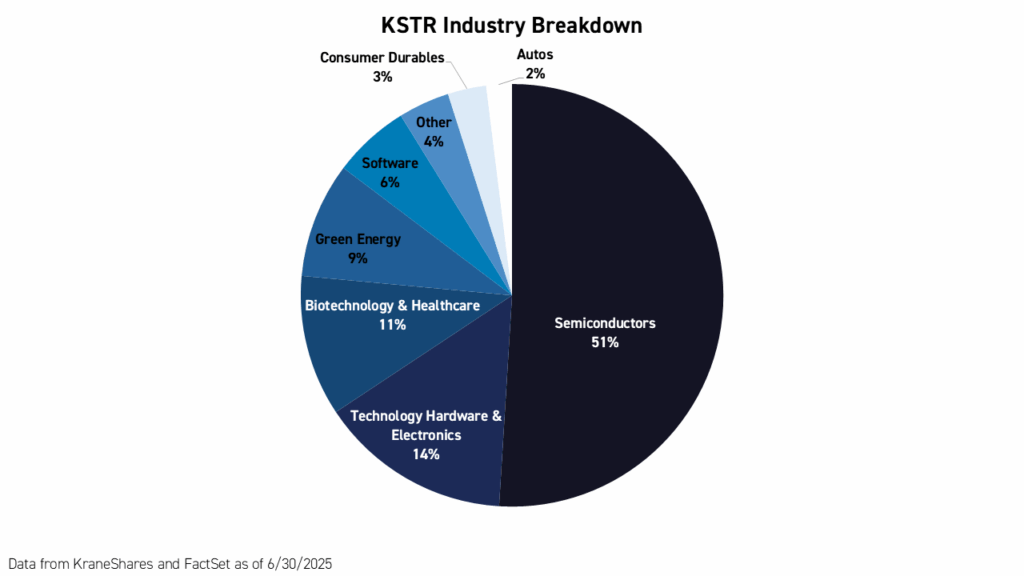
Over the past year, the top-performing industry within KSTR has been the Semiconductors, which accounted for slightly more than half of the portfolio’s average weight and contributed 30% to its overall return. Meanwhile, clean energy has been an underperformer.
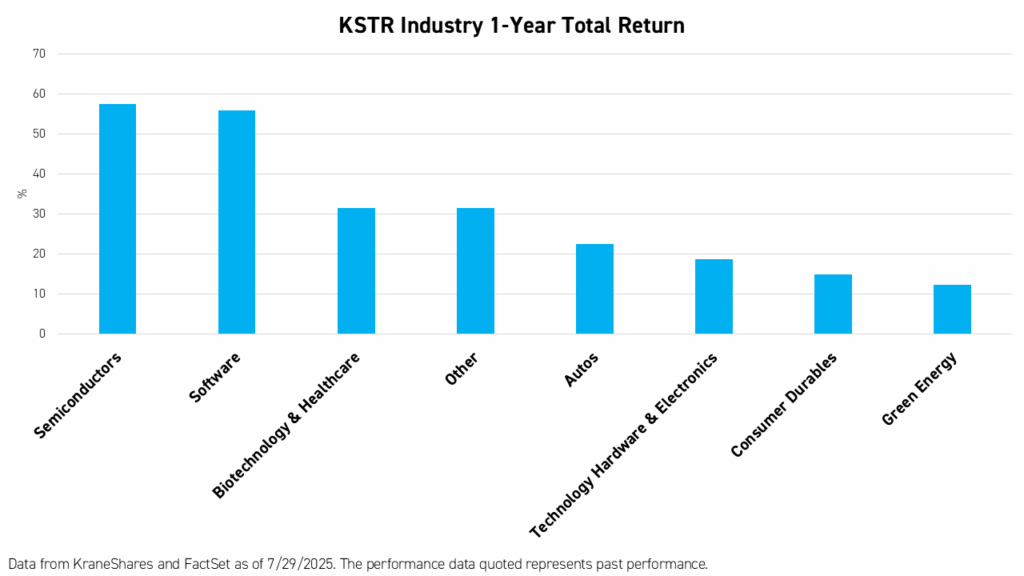
KURE: China's Health Care Sector Gets A Shot In The Arm
China’s health care market has immense growth potential. An aging population means that demand for healthcare is poised to soar. Add to this the fact that the country’s population currently spends just one tenth of the average per capita annual spending on health care services among the Organization for Economic Cooperation & Development (OECD) member countries,3 and its potential is likely unmatched in the rest of the world.
Despite this growth potential, 2023 and 2024 were challenging years for China’s health care sector. An anti-corruption campaign in hospital procurement, regulatory changes, and geopolitical headwinds constrained the industry. However, these headwinds appear to have resolved themselves by the end of 2024, contributing to China’s health care leaders' recovery in terms of share price and revenue, as suggested by recent market data. We believe the health care sector could continue to outpace China's equity market more broadly as the full impact of policy changes has not yet been felt yet and could continue to gradually make its way into corporate earnings.
The KraneShares MSCI All China Health Care Index ETF (Ticker: KURE) provides exposure to Chinese companies listed in the Mainland, Hong Kong, and the United States that are involved in the healthcare industry, specifically: Biotechnology, General Pharmaceuticals, Care Providers, Medical Devices, and Traditional Chinese Medicine.
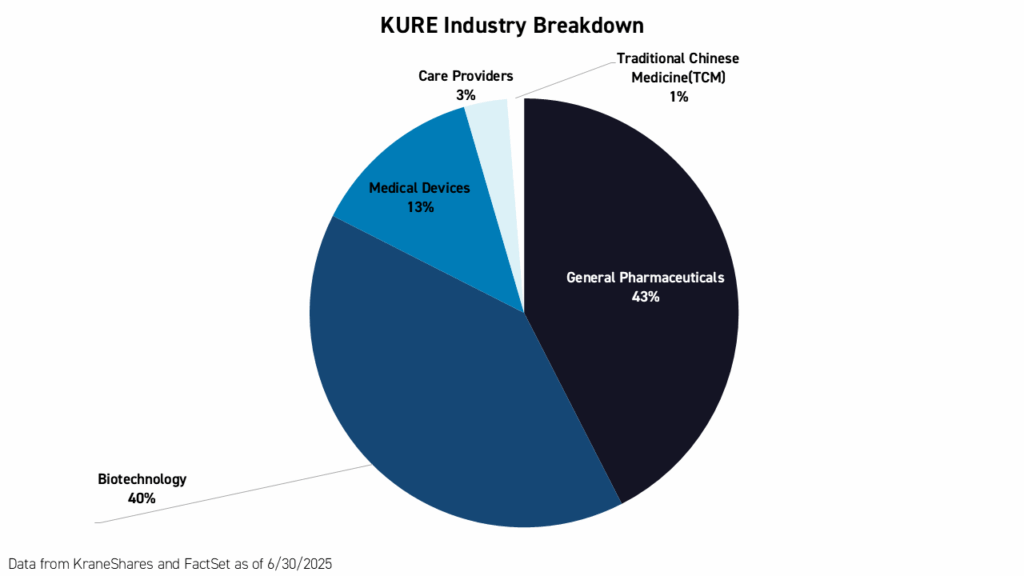
KURE’s returns for the past year were driven mainly by positive momentum for biotechnology stocks, especially Akeso, which gained +268.49%, and contract research organizations (CROs) WuXi Biologics and WuXi Apptec, which gained +256% and +201.40%, respectively.4 Akeso’s new lung cancer treatment’s glowing clinical trial results and the removal of a potential geopolitical overhang on Wuxi Biologics and Apptec: the BIOSECURE Act, which, if it had been passed, would have banned US entities receiving Medicare and Medicaid dollars from using their labs. Please click here to read our commentary on these and other developments in China's healthcare sector. Meanwhile, Traditional Chinese Medicine companies, which include the suppliers of herbal remedies and other non-Western health supplements and medicinal products, has a negative impact on the fund's overall return.
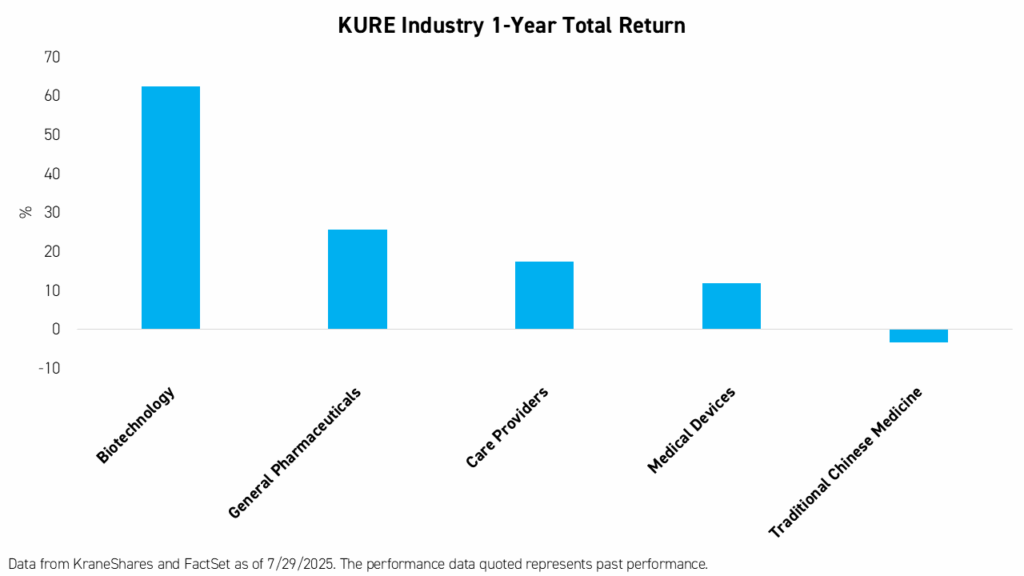
KGRN: China Gives A Dam (to Tibet)
China’s Premier Li Qiang attended the inaugural ceremony of construction for a new dam on the Yarlung Zangbo River in Tibet. The high-profile event christened a project that could dwarf the Three Gorges Dam as the world's largest hydroelectric facility, reflecting China's strategic pivot toward infrastructure-driven energy security and regional development.
The China Yajiang Group Co., Ltd., serves as the primary project manager for the $170 billion project. Operations are expected to be completed sometime in the 2030s, with the dam projected to generate 300 billion kilowatt-hours annually.5 The project highlights China’s push to expand its hydroelectric capacity as part of broader carbon neutrality targets. It is also expected to provide downstream benefits to renewable power companies across the country and improve electricity supply in Tibet, one of China’s most remote regions, paving the way for future development.
China Yajiang Group is poised to follow in the footsteps of the China Three Gorges Corporation (CTG), which listed a subsidiary on the Shanghai Stock Exchange shortly after the first generators for the Three Gorges Dam became operational in 2003.6 As such, analysts anticipate that China Yajiang Group or one or more of its operational subsidiaries will likely pursue an IPO between 2032-2035, coinciding with the project's initial power generation phase.
The KraneShares MSCI China Clean Technology Index ETF (Ticker: KGRN) provides exposure to companies powering China's renewable energy transition, focusing on alternative energy, sustainable water, pollution prevention, and energy efficiency. China Yajiang Group's eventual listing could represent one of the largest clean energy IPOs in Chinese market history and would likely qualify for the MSCI China All Shares Healthcare 10/40 Index, which is KGRN's index, making it into the fund as another holding in the Alternative Energy space.
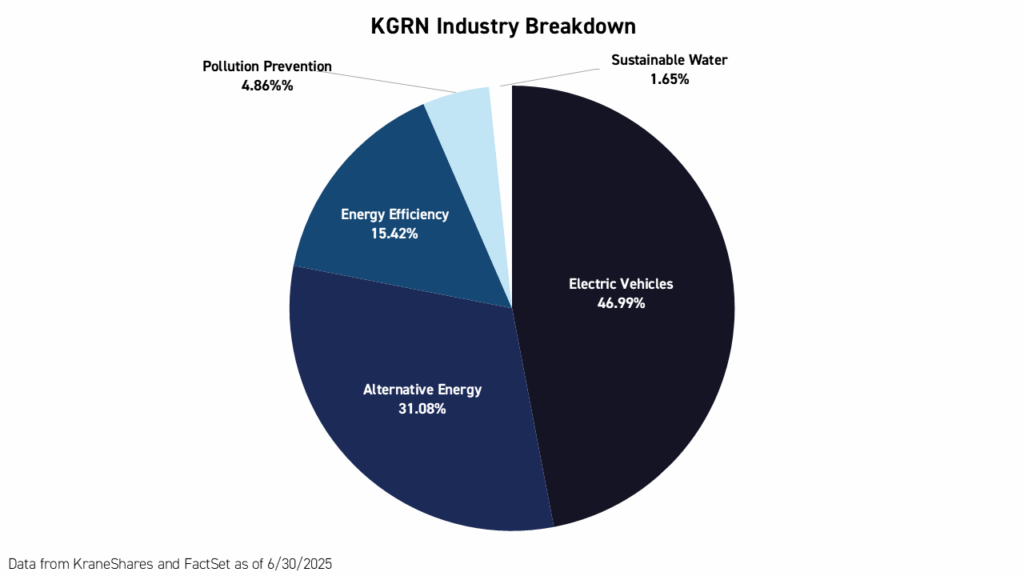
Over the past year, KGRN's return has been mostly driven by companies with businesses selling more energy-efficient devices and appliances and electric vehicle manufacturers, which now represent a significant weight within the fund. Meanwhile, solar power companies and others in the alternative energy space negatively affected the fund, mostly due to geopolitical headwinds in the solar trade. However, in July, guidance from the Ministry of Industry and Information Technology (MIIT) galvanized solar panel manufacturers to agree on production cuts, and a 30% planned reduction in photovoltaic glass production was achieved. Reductions in overcapacity should help alleviate pressure on solar panel manufacturers from extreme, race-to-zero competition between themselves and protectionism abroad.
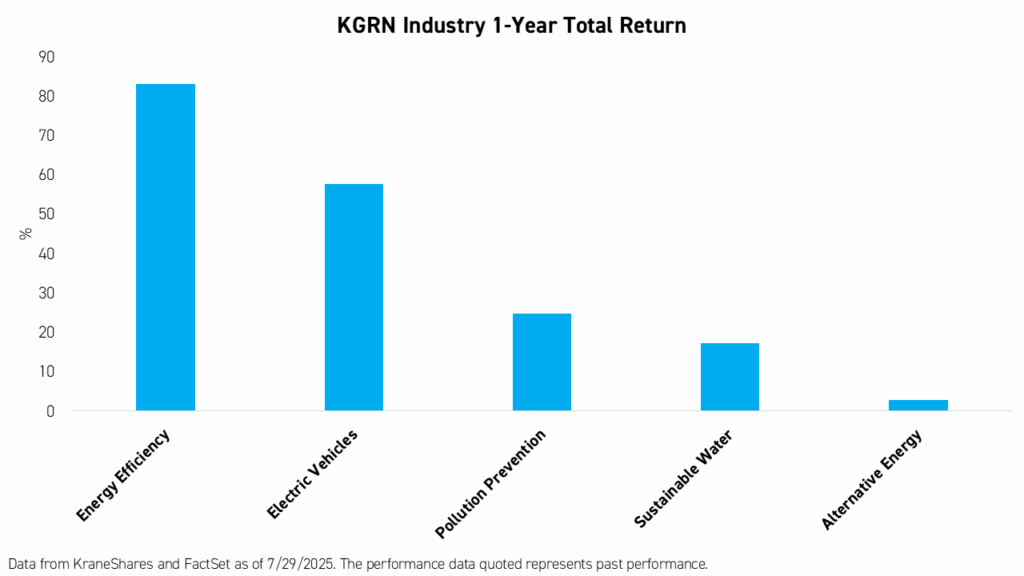
Conclusion
As the China re-rating continues, we believe investors should consider thematic exposures. Technology, China's continued green energy transition, and health care have the potential to drive China's growth and development over the next decade. We believe the recent early signs of recovery we are seeing in all three of these themes are encouraging, and potential indicators of future growth. Meanwhile, demographic and technological shifts in China could mean that the old China playbook needs to be updated to focus in on these key areas. While these themes present compelling opportunities, investors should also consider the potential risks involved.
High short-term performance from a limited number of the funds' holdings is unusual, and investors should not expect such performance to be continued over the long-term. Past performance does not guarantee future results.
Citations:
- Data from Bloomberg as of 8/15/2025.
- Data from the Shanghai Stock Exchange (SSE) as of 7/31/2025.
- Data from Organization for Economic Cooperation & Development (OEDC) as of 12/31/2024.
- Data from Bloomberg as of 7/20/2025.
- “China Embarks on World’s Largest Hydropower Dam, Capital Markets Cheer.” Circle of Blue, 2 Aug. 2025.
- "China Yangtze Power Company (CYPC) Company Profile & Introduction". Moomoo.com.
Hang Seng Index: The Hang Seng Index ("HSI"), the most widely quoted gauge of the Hong Kong stock market, includes the largest and most liquid stocks listed on the Main Board of the Stock Exchange of Hong Kong. The index was launched on November 24, 1969.
Shanghai Composite: The Shanghai Stock Exchange Composite Index is a capitalization-weighted index. The index tracks the performance of all A-shares and B-shares listed on the Shanghai Stock Exchange. The index was launched on July 15, 1991.
S&P 500 Index: The S&P 500 Index is widely regarded as the best single gauge of large-cap U.S. equities. There is over USD 9.9 trillion indexed or benchmarked to the index, with indexed assets comprising approximately USD 3.4 trillion of this total. The index includes 500 leading companies and covers approximately 80% of available market capitalization. The index was launched on March 4, 1957.
Global Flows: This refers to general investments into China's stock market from international investors. We track a variety of flow factors, including flows into our products.

